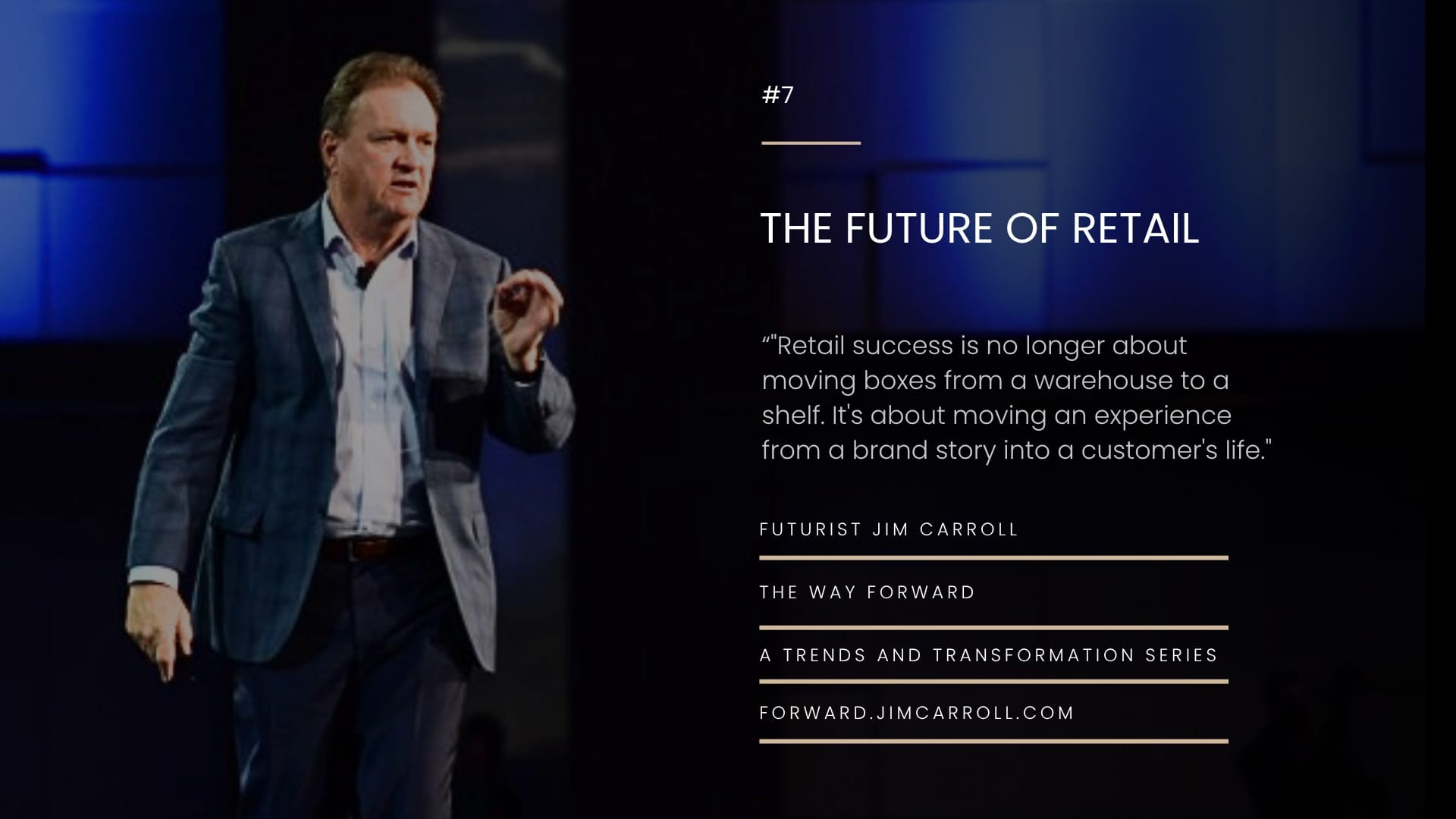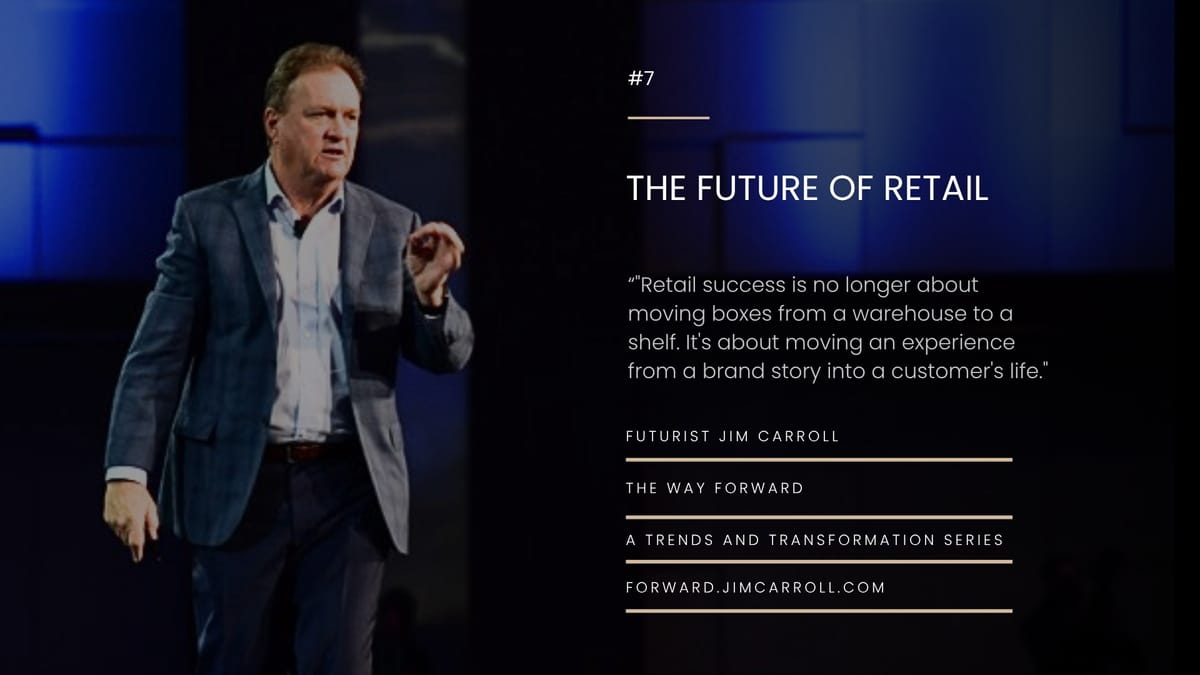“Retail success is no longer about moving boxes from a warehouse to a shelf. It's about moving an experience from a brand story into a customer's life." - Futurist Jim Carroll

In 2025, the headwinds are severe, and the path forward seems shrouded in fog. We’re living through one of the most volatile and unpredictable periods in recent memory. With that being the case, I am writing this new series, The Way Forward: A Trends and Transformation Series, taking a look at the trends redefining industries, and actionable strategies organizations must pursue to align with these realities. The entire series will be found at forward.jimcarroll.com
Perhaps no industry has been impacted more by the forces of disruption - the rise of Amazon, e-commerce, supply chain sophistication, changing consumers, and more.
And yet the fact is, the retail landscape is undergoing and still very much in the midst of a tectonic shift, moving decisively away from a product-centric universe to one governed by experiences, relationships, and values. It's all about the entertainment, engagement, and experience, being driven by a new generation of consumers who wield unprecedented influence through digital platforms. For retailers, technological adoption is no longer a matter of choice; it is a fundamental and urgent response to a profound change in consumer power, behavior, and expectations.
Success through 2030 will be defined not by what a retailer sells, but by how it engages, empowers, and aligns with the values of its customers. Let's start with the major trends impacting the sector.
The Shifting Landscape: 10 Trends Redefining Retail & Supply Chain
To thrive in the new era of commerce, one must first understand the powerful currents reshaping the entire ecosystem, from the factory to the front door.
- The end of inventory. The traditional "make-to-stock" model is being replaced by agile "make-to-order" and direct-to-consumer systems, with technologies like 3D printing enabling on-demand production.
- The experiential imperative. The physical store is being reimagined as a stage for brand immersion and community engagement, offering tactile, multi-sensory experiences that e-commerce cannot replicate.
- The autonomous last mile. Consumer expectations for speed are fueling massive innovation in logistics, with autonomous delivery vehicles (ADVs), sidewalk robots, and aerial drones poised to redefine delivery.
- The AI-powered supply chain. Artificial intelligence is the new engine of commerce, used to generate highly accurate demand forecasts, optimize inventory, and orchestrate logistics in real-time.
- Phygital convergence. The future isn't online or in-store; it's a seamless blend of the physical and digital, bringing the convenience and personalization of the online world into the physical space.
- The great decoupling & supply chain resilience. Geopolitical risk has supplanted cost as a primary driver of supply chain strategy, forcing a pivot from pure efficiency to robust resilience through diversification and regionalization.
- The ascendant consumer. Generation Z and Millennials are the new architects of retail, demanding transparency, sustainability, and authentic alignment with their personal values from the brands they support.
- The circular economy. A new business paradigm is emerging, focused on eliminating waste and keeping products in use through models like resale, rental, repair, and remanufacturing.
- The collapse of attention spans. The average consumer scans 12 feet of shelf space per second, and their attention is constantly fragmented by digital devices.
- The sentient network. The Internet of Things (IoT) is the sensory nervous system of the modern supply chain, providing the real-time visibility necessary for predictive analytics and automated decision-making.
A Deeper Dive: The Most Significant Forces Reshaping Retail
While all ten trends are critical, a few stand out for their immediate and profound impact. Their convergence is creating a powerful, self-perpetuating flywheel of innovation! Retailers must jump on the flywheel to stay relevant!
The Experiential Imperative: The Store as a Stage!
The role of the brick-and-mortar store has been irrevocably altered.
In an era where any product can be purchased online, the physical store must offer something e-commerce cannot: an experience!. Forward-thinking retailers are embracing this shift by "turning the store into a stage." Nike's House of Innovation in New York City is a perfect example, a dynamic brand ecosystem where shoppers use the Nike app to scan mannequins, reserve items, and receive personalized recommendations in smart fitting rooms.
Likewise, Lululemon has successfully positioned its stores as community hubs, hosting in-store yoga classes and wellness workshops. This strategy builds deep, authentic customer relationships, underscored by data indicating that 85% of consumers are more likely to purchase after attending a live experiential marketing event.
Customers want more than shopping - they want more than a transaction. They want fulfillment!
Phygital Convergence: Erasing the Lines Between Online and Offline
The future of retail lies in the seamless integration of physical and digital channels into a unified customer experience, a concept known as "phygital."
Warby Parker, a brand that arrived online, provides a powerful case study of what happens when the lines are blurred. Its physical locations are designed as simple, streamlined showrooms. Customers can try on glasses and, if they choose not to buy immediately, save the model numbers to their online account to revisit later, creating a frictionless, low-pressure journey. The online and offline worlds are linked together into a seamless blend.
A pivotal technology driving this is augmented reality (AR). Sephora's in-store AR mirrors, which allow customers to virtually try on makeup, have been shown to result in a 31% boost in sales and 90% higher conversion rates. In home goods, AR apps like IKEA's Place see a significant 22-40% reduction in product return rates by eliminating purchase uncertainty.
The Ascendant Consumer: Decoding the Gen Z and Millennial Mindset
Generation Z and Millennials are the new architects of the retail paradigm. They have no attention span, little loyalty, and are digital-first in everything they do. This means that their behaviors and motivations are non-negotiable realities.
What's the impact? Social media is the primary source of shopping inspiration for 97% of Gen Z consumers. The "TikTok Made Me Buy It" phenomenon is a testament to the power of viral trends. However, their digital fluency is matched by a pragmatic approach to finance, with 62% of Gen Z using "Buy Now, Pay Later" (BNPL) services.
Perhaps most defining is their conditional approach to brand loyalty. A majority of Gen Z (57%) are less loyal to brands now than before the pandemic, and loyalty must be continuously earned through alignment with their personal values. Data shows that 64% of Gen Z would pay more for an eco-friendly product and would boycott a company for unethical labor practices.
The AI-Powered Supply Chain: From Reactive to Predictive
Artificial intelligence is enabling a fundamental transition from traditional, reactive planning to a new paradigm of predictive and prescriptive optimization. While there is a lot of AI hype, the reality is that AI has long proven its' real value in deep data and analytics.
Leading platforms are delivering quantifiable results. Blue Yonder's Luminate Platform enables **Walgreens** to meet a 30-minute order promise and helps DHL achieve 7% transportation cost savings. Using Kinaxis's AI-powered digital twin, a health and beauty retailer achieved a 30% increase in forecast accuracy, a 50% reduction in promotion planning hours, and a 31% decrease in stock-outs. o9 Solutions' "Digital Brain" helped a global food producer achieve a 5-8% forecast accuracy improvement by incorporating over 230 external demand drivers.
Gartner predicts that such AI agents could take over as many as half of all supply chain tasks by 2030.
The Great Divide: Barriers to a Modern Retail & Logistics Industry
While the future holds immense promise, the path to transformation is littered with significant barriers that are creating a divide between the agile innovators and the incumbents struggling to adapt.
- The anchor of legacy: Old technology, old computers, old code! For many incumbent retailers, legacy IT systems are not just inefficient; they are strategic liabilities. These antiquated, monolithic systems are difficult to modify, create data silos, and consume a staggering 58-80% of the IT budget simply on maintenance, leaving little capital for innovation.
- The human element: An estimated 70-95% of digital transformation initiatives fail, not due to faulty technology, but due to cultural resistance, leadership misalignment, and a failure to manage the human side of change. This is compounded by a skills gap in critical areas like data science and AI.
- Geopolitical volatility: The era of hyper-efficient global supply chains built on the assumption of geopolitical stability is over. 90% of executives now view geopolitics as the greatest risk to economic growth, with disruptions projected to cost global supply chains over $1 trillion in 2025 alone.
- Channel conflict: For manufacturers and brands with established wholesale and retail partnerships, the strategic imperative to move to a direct-to-consumer model creates significant conflict with their existing channel partners.
- The tyranny of the urgent: Many retailers are trapped in a cycle of short-term, reactive decision-making, focused on quarterly sales targets rather than long-term strategic transformation. This "aggressive indecision" prevents necessary investments in future-focused technologies.
Beating the Odds: Case Studies in Retail & Supply Chain Innovation
Despite the barriers, pioneers are proving that transformation is possible. Their success stories provide a powerful blueprint.
- The AI-Powered Supply Chain (Blue Yonder & Walgreens): By implementing Blue Yonder's Luminate Platform, Walgreens can promise online order fulfillment in as little as 30 minutes, demonstrating how AI-driven demand sensing and automated replenishment can translate directly into a superior customer experience and a powerful competitive advantage.
- The Autonomous Last Mile (Walmart & DroneUp): In its quest to leverage its vast physical store footprint for e-commerce fulfillment, Walmart has partnered with DroneUp to test the delivery of small packages via drones from its stores in Arkansas. This positions the retail giant at the forefront of redefining the speed and economics of the last mile.
- Manufacturing on Demand (Dr. Scholl's) Dr. Scholl's uses 3D printing to create custom shoe insoles. Customers use an app to take photos of their feet, which generates a 3D model based on 400 mapping points. A personalized insole is then printed and delivered within days, showcasing how mass customization can be delivered at scale.
- The Circular Economy (Patagonia & IKEA): Patagonia's "Worn Wear" program and IKEA's "Buy Back & Resell" service are prime examples of circular business models. By facilitating the buying and selling of their own pre-owned products, these brands capture a share of the secondary market, increase customer lifetime value, and reinforce their commitment to sustainability.
The Innovator's Playbook: Actionable Strategies
What do retailers need to do>? Get on the flywheel of innovation - the trends aren't going to stop, but will only accelerate.
- Turn your store into a stage: Reimagine the purpose of your physical footprint. Invest in creating unique, engaging, and shareable in-store experiences that build community and brand loyalty, turning your store into a marketing channel, not just a sales channel.
- Master the last mile: Recognize that the delivery experience is now a core part of your brand promise. Partner with or invest in innovative last-mile logistics solutions to offer customers faster, more flexible, and more sustainable delivery options.
- Architect a seamless "phygital" journey: Break down the silos between your physical and digital teams. Design a unified customer journey that allows shoppers to move effortlessly between online and in-store channels, with consistent branding, data, and experience.
- Innovate at the speed of the consumer: Your product development and marketing cycles must now operate at the speed of social media. Create agile, cross-functional teams that can rapidly identify emerging trends and launch new products or marketing campaigns in weeks, not years.
- Embrace the circular economy: Move beyond linear "take-make-dispose" models. Explore opportunities in resale, rental, repair, and remanufacturing to create new revenue streams, build deeper customer relationships, and meet the growing demand for sustainability.
- Build a brand that matters: Authenticity, transparency, and sustainability are the new currency of brand loyalty. Align your brand values with the expectations of the next generation of consumers and be prepared to prove it with real, verifiable actions.
The retail and supply chain industries are in the midst of a once-in-a-generation transformation.
The forces of digitization, personalization, and logistical innovation are not just creating new efficiencies; they are continuing to change the entire concept of retail. For an industry that has been defined by its physical footprint and historical processes, the coming decade will continue to be a period of profound challenge and unprecedented opportunity.
The future of commerce will not be built with the blueprints of the 20th century - the pandemic taught us that. It will be coded with intelligent algorithms, delivered by autonomous fleets, and experienced in immersive, personalized environments, guided by a new generation of leaders who are not afraid to build a bolder, faster, and smarter world.
Futurist Jim Carroll covers retail issues in his blog at https://jimcarroll.com/category/retail-trends

